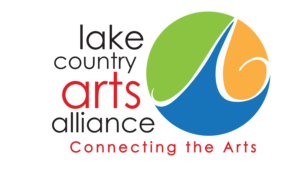The Arts Give You Smarts!!
The Lake Country Arts Alliance is proud to bring you interesting articles about the arts. In this segment, the importance of exposure to the arts is discussed.
It is a long known fact that the arts must be an integral part of youth education.
The particular art is inconsequential……all arts disciplines provide effective means for student growth. In a ten-year national study by Shirley Brice Heath of Stanford University, it was discovered that young people from under-resourced communities who were involved in non-school arts-based community programs were:
- 4 times more likely to win an academic award, such as the honor roll.
- 8 times more likely to receive a community service award.
- 3 times more likely to win a school attendance award.
- 4 times more likely to participate in a math or science fair.
- Much more likely to score higher on their SAT college admission test scores
According to Lisa Phillips and the NAEA, here’s a list of skills that young people learn from the arts:
Creativity is what distinguishes humans from other animals. The ability to think on your feet, approach tasks from different perspectives and think “outside of the box” is unique to humans. In an arts program, a child will be asked to recite a monologue 6 different ways, create a painting that represents a memory, or compose a new rhythm to enhance a piece of music. If children have practice thinking creatively, it will come naturally to them now and in their future careers. The arts teach students to think through and within a material. All art forms employ some means through which IMAGES become REAL.
Confidence in taking command of the stage, learning to paint, or writing a poem gives children practice stepping out of their comfort zones and allows them to make mistakes and learn from them. As a child continues with an artistic endeavor, such as learning to play the piano, he or she learns perseverance and dedication.
Problem Solving begets artistic creations and is itself a creative process. How does one turn this clay into sculpture? How can one portray a particular emotion through dance or recitation of a poem? How will my character react in this situation? Without even realizing it kids that participate in the arts are consistently being challenged to solve problems. All this practice problem solving develops children’s skills in reasoning and understanding. The arts teach children that problems can have MORE than ONE solution and that questions can have more than one answer. The arts teach children that purposes are seldom fixed, but change with circumstance and opportunity. Learning in the arts requires the ABILITY and a WILLINGNESS to surrender to the unanticipated possibilities of the work as it unfolds.
Focus, collaboration, and accountability are key skills developed through ensemble work. Keeping a balance between listening and contributing involves a great deal of concentration and focus. Recent research has shown that this improves children’s abilities to concentrate and focus in other aspects of their lives. When children practice creating collaboratively, they must learn to be part of a team, to be accountable. They learn about working together, sharing responsibility, and compromising with others to accomplish a common goal. They learn that their actions affect other people, that when they are not prepared or on-time, that other people suffer. They learn that it is important to admit that you made a mistake and take responsibility for it, and because mistakes are a regular part of learning in the arts, children begin to see that mistakes happen. We acknowledge them, learn from them, and move on. The arts teach students that SMALL DIFFERENCES can have LARGE EFFECTS
Receiving constructive feedback about a written piece or visual art piece is a regular part of any arts instruction. Children learn that feedback is part of learning and it is not something to be offended by or to be taken personally. It is something helpful. Criticism is NOT failure! The goal is the improvement of skills and evaluation is incorporated at every step of the process. Each arts discipline has built in parameters to ensure that critique is a valuable experience and greatly contributes to the final piece’s success.
Students of the arts learn good judgment. Unlike much of the curricula in which correct answers and rules prevail, in the arts, it is judgment rather than rules that prevail.
Whether students continue to pursue artistic disciplines through adulthood as professionals or not, fostering a love of the arts in our young people is shown to have lasting positive effects on these individuals as well as our communities.
For ways to help your community booster the arts for children, consider reaching out to your favorite local arts organization with a donation!
